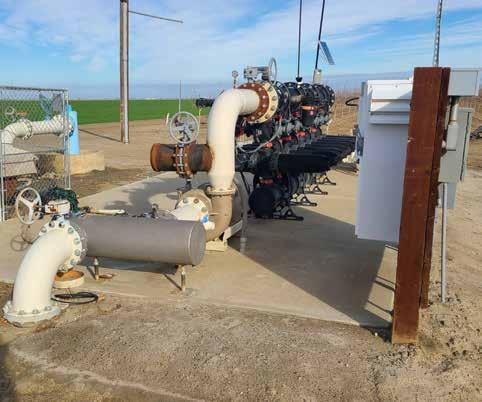
14 minute read
IIoT and automation technology saves time and better control
Farm Data Systems and Azcal Management reduce pump management time by up to 90%. FDS Ignition client app for Water Informatics can be used on phones to power up pumps within seconds, along with an ability to see pressures and flows continuously and make adjustments without visiting any of the sites directly.
AZCAL MANAGEMENT FARMS 8,700 ACRES IN Kings County, California, in the heart of the San Joaquin Valley. They farm a diverse range of crops including pistachios, wine grapes, alfalfa, and row crops like onions, garlic, and tomatoes.
The Customer
Pioneers in precision agriculture technology, Azcal focuses on increasing production, on efficiency, and on improving crop quality.
In drought-prone California, farmers walk a fine line on water use. Water costs, government regulations, and concern for future water availability all mean they must start focusing much more on providing just enough water for crops, not too much or too little.
One of the Azcal ranches has 12 deep-well pumps, all with VFDs (variable frequency drives), feeding a single mainline serving a 4,000 acre ranch just south of Lemoore, California.
Monitoring and controlling these pumps used to be a full-time job for farm managers Jake Sheely and Marty Rhoads. It took six to seven hours throughout each day to drive around the ranch and make the needed micro adjustments to pumping and irrigation systems.
Their monitoring was vital, ensuring that system pressures and flows were within range and that pumps were operating efficiently. With four or five well pumps running at the same time, Jake and Marty had to be extremely diligent to avoid both low and high pressure events and often had to switch wells based on farming needs.
The wells must be kept in operation but not overdrawn. A drop in the flow rate would mean the well was overdrawn, and if air was sucked into the pump, the well could require thousands of dollars to repair.
In addition, like many growers, they also suffered from power failures and incoming voltage spikes. It could be several hours before they realized a pump was no longer running or had burned up.
The time involved in manual monitoring and control was just too much. Azcal looked for a simple way to automate their water management and track pumping events for monthly water accounting.
Azcal interviewed several Ag Tech providers about their need for remote pump monitoring and control. They tried proprietary tools designed for pump control, but although these tools worked for one pump and 40 acres, none of them could integrate everything at scale. And there was limited support for remote control or sophisticated PID loop control.
Discouraged, Azcal was dubious when Farm Data Systems (FDS) in Madera, California, approached them with some new technology. However, FDS owner and president John Williamson had worked on projects for them with a previous company, so they were willing to listen.
“No one has been able to deliver what we needed,” said Jake.
As John notes, agricultural customers are trying to solve fairly simple problems, but there are so many difficulties that it becomes complex. Assets are spread out over wide distances. You can’t run Ethernet wiring; the system has to be wireless. And cost is a huge factor, as farms don't usually have big budgets.
But the engineers at FDS have spent the last 20 years figuring out how to make technology in the field both relevant and costeffective to growers. In the early years they used their own technology for monitoring, but customers began asking for more and more features. So FDS standardized on Opto 22 hardware and Ignition software from Inductive Automation®, bringing agriculture into the internet of things.
“Five years from now I don’t know how anyone will be able to farm efficiently without this IoT technology,” says John.
Using the Opto 22 hardware and Ignition software, FDS has developed an end-to-end field monitoring and automation solution for crop irrigation management.
Opto 22 groov EPIC controllers and groov RIO modules connect to sensors and equipment in the field to gather data and automate control.
FDS’ Water Informatics platform, an Ignition project hosted on FDS’ private cloud, provides
All Azcal wells and irrigation filter stations are equipped with VFDs and flow meters.
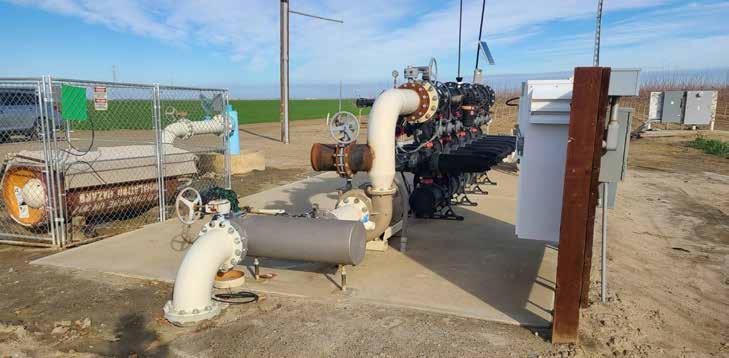
Azcal well pumps all feed the same mainline pipe, leading to complex pressure management requirements.
the control and data that farmers need in a way that they understand and can easily use. Each customer has a private view based on their login that shows just the assets and information for their ranch.
By avoiding expensive custom hardware that can be time consuming to build and maintain, FDS can keep prices affordable while also limiting downtime if something needs to be replaced or upgraded. With off-the-shelf controllers, sensors already widely used in many other industries, and their own easyto-use software, FDS’ systems are very affordable for farmers.
Not only has the company significantly improved irrigation management at over 500 farms covering more than 50 crops, they also farm their own 200-acre technology lab to test system improvements.
The Solution
What Azcal needed was a controller at each well pump, fully integrated with their existing VFDs, that would allow them to remotely start and stop pumps as well as make micro-adjustments to either the speed or the pressure setpoints. They also needed reliable monitoring of flow meters and incoming voltage.
FDS met Azcal’s needs with an integrated, modular architecture that can be easily adapted to meet the unique requirements of each customer.
The Hardware
Farm Data Systems began using Opto 22 controllers and I/O several years ago. They had used Allen-Bradley® products for pump control, but the systems were too expensive for most farms.
When they discovered that new IoT products from Opto 22 could do the same things more efficiently, John says, “Opto opened the door into Ag for us.”
Initially they chose the Ethernet-based, rack-mounted SNAP PAC R-series controllers and I/O for field installations. When Opto 22 released groov EPIC and groov RIO, however, they saw an opportunity to reduce costs further.
“There are 60,000 irrigation pumps in California, and 60-70% have only got four to six I/Os,” says John. “It doesn’t make sense to put a full controller in there.” Instead, FDS uses a groov RIO universal I/O module, a small unit that offers a broad range of softwareconfigurable signal types, plus built-in security and IoT communications.
For system control, FDS uses the sturdy groov EPIC edge programmable industrial controller. Designed for industrial automation and the internet of things, the EPIC offers security features including a configurable device firewall, user accounts and authentication, data encryption, security certificate management, VPN client, and dual independent Ethernet ports. With control programming options and the ability to run Ignition software, EPIC is a step ahead of other industrial controllers on the market.
Both groov EPIC and groov RIO include Node-RED and MQTT communications, which FDS is increasingly using to streamline data capture. A groov RIO at a remote location, for example, can send data via MQTT directly to an MQTT broker on the Ignition server.
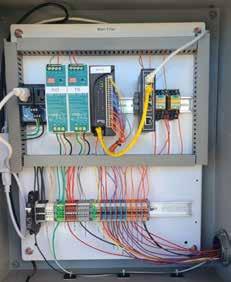
SOURCE: OPTO 22
The groov RIO with 10 universal I/O channels is well suited to Ag pumps.
The Software
A key part of Farm Data Systems’ installations is their Ignition project software, Water Informatics. With a UDT library of all the features they provide—pumps, flow meters, moisture probes, every physical device— new assets can be easily copied and pasted to build out a new project in minutes. Once added, every feature can be expanded to other customers.
Because the architecture is hosted, FDS just needs to turn on the customer’s access to their individual pages. Adding a new client is “super fast,” as John notes. “The software part can be completed in a few days. Installing hardware is the bulk of the work.”
Using industry-standard controller hardware and SCADA software, FDS offers almost 30
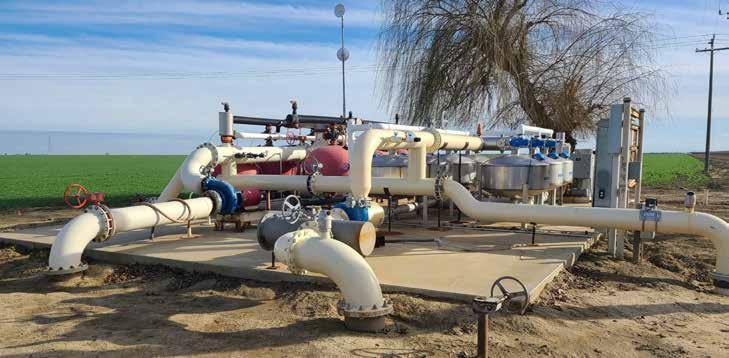
Azcal filter stations typically serve multiple crops in fields of various sizes.
different modules hosted on a secure web server, from soil moisture monitoring to full irrigation automation. And they constantly add new modules based on customers’ needs.
For Azcal, FDS began by installing Opto 22 SNAP PAC I/O units at five well pumps. As soon as groov RIO was available, they installed groov RIO modules at an additional seven well pumps. The well pump I/O reports data on voltage transducers, virtual speed potentiometers, remote setpoints, current switches, VFDs, and flow meters at each location, sending that data over WiFi via an Ethernet switch and a Ubiquiti bridge to the main tower location.
At the tower location a groov EPIC acts as the central controller, running an Opto 22 PAC Control strategy. From a dedicated network at the tower site, data is shared over a VPN from the EPIC, through the internet. The customer data lives in Inductive Automation’s Ignition SCADA software on the Microsoft Azure Cloud Server.
The Water Informatics software gives Azcal the ability to access their system via mobile devices. From their phones or other devices with a web browser, Azcal can: • Remotely start and stop pumps • Control VFD frequency on four pumps using a virtual speed pot


Azcal M&S Ranch system architecture
• Control pressure setpoint virtually on the remaining eight VFDs • Continuously monitor pump pressure & flow rate • Track VFD frequency, voltage, current, and power • Monitor incoming line voltage and well health • Receive alerts on critical operational issues and general pump activity • Receive reports on pump activity and water usage
The Result
The manual monitoring and adjustments that used to take Azcal six or seven hours per day now take just a few minutes a day.
“We are thrilled with the FDS solution. I am on top of pump management first thing in the morning before the day gets going. It just works!” says Jake Sheely.
From day one, Jake and Marty have been able to use the FDS Ignition client app for Water Informatics on their phones to power up any of their pumps within seconds. Moreover, they can see the pressures and flows continuously changing and make adjustments without having to jump into their truck to visit any of the sites directly. They also have visibility into their incoming voltage for the first time and receive text alerts any time the system loses power.
And as John notes, every part of the platform, from the Opto 22 I/O, to the Ubiquiti communications, and finally to the Inductive Automation SCADA, can be trusted to be secure and reliable.
The Future
“The combination of Opto and Ignition is very flexible,” John says. “I can just keep adding features all day. We’ve already proposed to come back to add cascading PID control so they don’t have to do the remote control themselves. It will do it for them.”
Each addition builds Farm Data Systems’ ability to help existing and new customers. Says John, “Every time we do something for them, we just add more features for all our customers.”
Azcal has exactly the solution they needed at an affordable price. The latest industrial control technologies adapt well to an agricultural setting and start delivering ROI immediately. As a result, Azcal is already rolling out the same technology across their other ranches, with additional features including valve control and irrigation scheduling.
Application and technical article provided by
Opto 22.
Visit Website
Creating a zone-basis, industrial network architecture can reduce network damage but cybersecurity experts are proposing more proactive actions to protect industrial networks. An industrial intrusion prevention system (IPS) can effectively counteract intrusions and reduce their impacts on industrial systems.
Whitelisting control realized by only allowing access of the authorized devices, service, protocol format, and control commands on a whitelist.
INCREASED CYBERSECURITY INCIDENTS HAVE been crippling critical infrastructure and harming businesses. Some are targeted attacks, such as ransomware attacks; however, some are nontargeted incidents, such as contamination through malware that gains access to an unauthorized computer and spreads to the whole industrial control network.
Taking the approach of creating zone-basis industrial network architecture can reduce the damage. In the meantime, cybersecurity experts are also proposing more proactive actions to protect industrial networks. These actions can be realized by an industrial intrusion prevention system (IPS), which can effectively counteract intrusions and reduce their impacts on industrial systems.
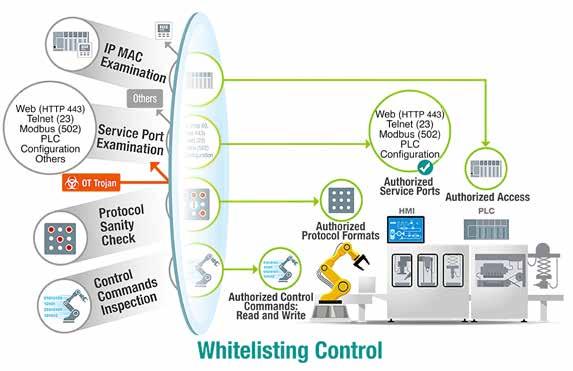
What is an IPS?
An IPS is a form of network security designed to detect and block identified threats by constantly monitoring networks, looking for possible malicious cyberincidents and logging information about them. It features deep packet inspection (DPI) technology, enhancing network security visibility, and ultimately helps mitigate risks and protect industrial networks from security threats.
IPS tailored for industrial networks
Although IPS technology has worked very well on IT networks for a while, it is difficult to directly deploy an IPS in OT networks because the first priority of OT networks is availability and performance, while the first priority of IT cybersecurity is confidentiality. Implementing an IPS in OT networks without considering the daily operations requirements of OT engineers could possibly block control commands that are important to production, consequently disrupting operations. To fulfill the OT cybersecurity requirements, it is essential to empower OT-centric DPI technology. OT-centric DPI can identify multiple industrial protocols and allow or block specific functions, such as read or write access. Based on the identified protocol, an industrial IPS can then prevent any unauthorized protocols or functions. This ensures that the traffic on industrial networks is trusted and non-malicious.
Whitelisting control defines granular access control
Whitelisting control is an approve-and-go mechanism realized by only allowing access of the authorized devices, service, protocol format and control commands on a whitelist. The mechanism ensures that all network activity on industrial networks is authorized and network operators can define granular access controls at different levels depending on operational requirements.
For instance, OT engineers can define a whitelist of devices and services or IP ports that are allowed to access all or part of the entire network. In addition, it is also feasible to define the authorized protocol format to prevent unauthorized commands from passing through networks.
What’s more, OT engineers can even define which control commands can pass through the network to reduce human error associated with sending a wrong control command. With whitelisting control, the likelihood of a DoS attack by OT Trojans can be significantly reduced.
Protection Scenarios
1. Block and Contain Malicious Traffic
An industrial IPS is designed to protect industrial networks by blocking malicious traffic from the network to edge devices and by containing malicious traffic at edge devices. It can be placed in front of critical assets such as PLCs and HMIs to enhance network security
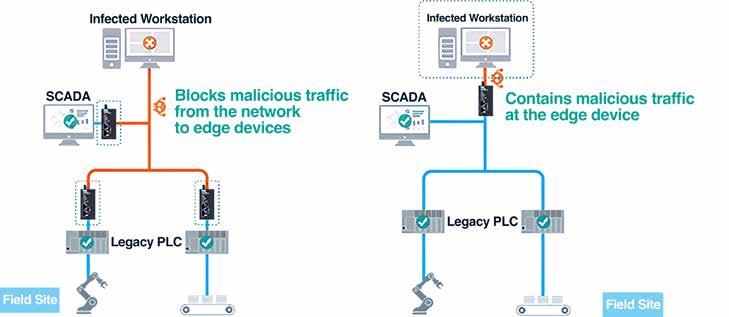
Azcal M&S Ranch system architecture
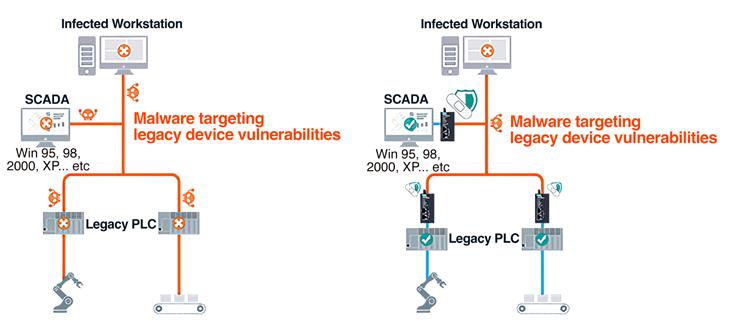
Azcal M&S Ranch system architecture
and ensure network availability while protecting critical assets from being manipulated by malicious actors. For instance, when there is a workstation being infected with malware, the malware often would find its way to spread to as many devices and networks as possible. It could have probably spread to most of the devices on the networks by the time an OT engineer or network operator notice it.
Therefore, both proactive actions are important to mitigate the risks. One action is to block malicious traffic at the first place when the network is contaminated; the other is to contain it to a manageable degree if it unfortunately occurs. 2. Virtual Patching to Reduce a System’s Exposure to Cyberthreats
Frequent patching significantly reduces a system’s exposure to cyberthreats. However, it continues to be a critical challenge in OT environments. Devices on industrial control systems are not always available for updates when vulnerabilities are identified. For instance, a production operation keep up and running for a period of time before its next maintenance schedule.
Sometimes, updates are probably not feasible because devices on industrial control systems may have already passed their long life cycle and vendors are not providing updates anymore. Virtual patching technology can help complement existing patch management processes by shielding against vulnerabilities. Virtual patching acts as an agentless emergency security tool that OT administrators and operators can use to quickly remedy vulnerabilities on affected OT equipment.
In order to pursue operational efficiency and availability, it is always important to take cybersecurity into consideration. The thought that OT networks are isolated and secure has been cut down to size by several cybersecurity incidents in manufacturing plants. Two different directions can be taken to enhance network security. One is to ensure that your industrial networks have a secure foundation–secure network infrastructure, which allows authorized traffic to flow to the correct places.
Alternatively, you can identify critical assets and give them layered, proactive protection such as an industrial IPS and whitelisting control.
Roger Chen, Manager of Cybersecurity Market Development, Moxa.










